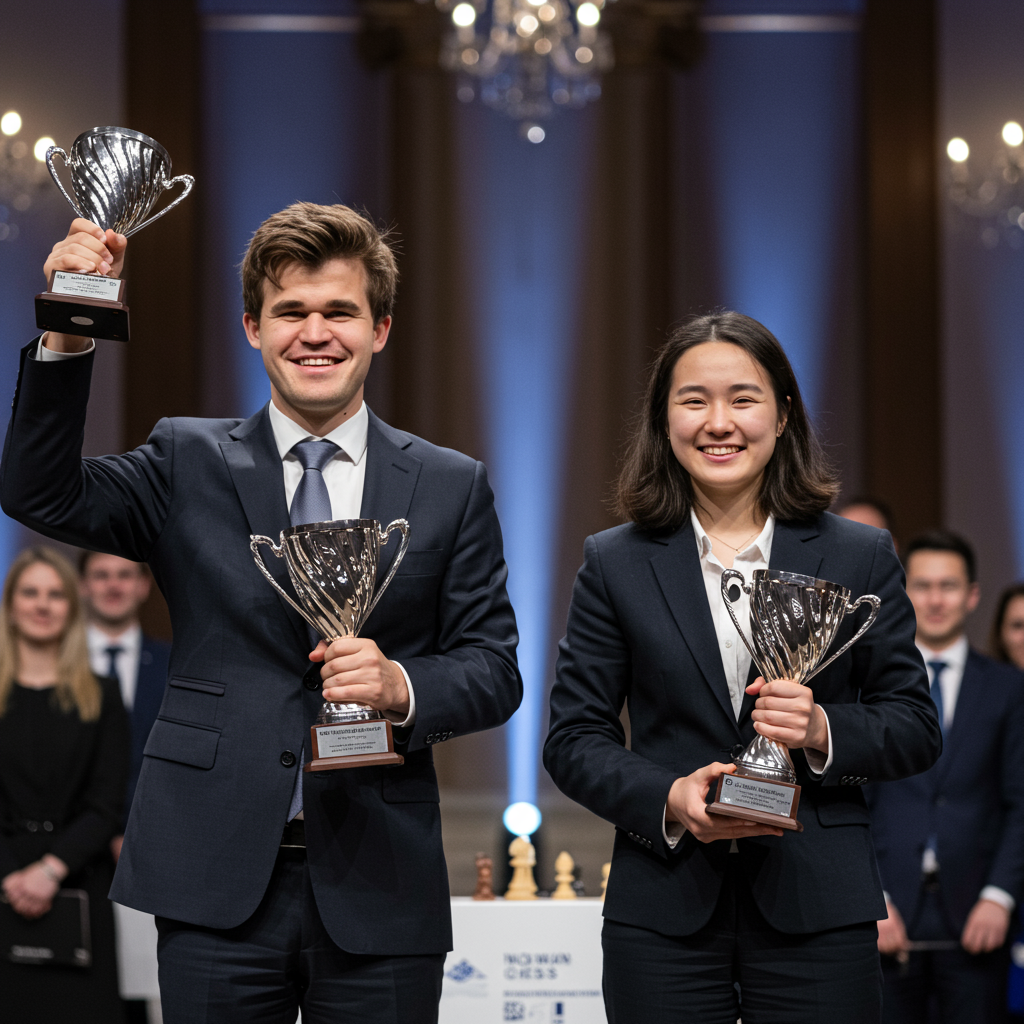The 2025 edition of Norway Chess in Stavanger concluded with a thrilling final round, crowning GM Magnus Carlsen as the Open section champion for an incredible seventh time and GM Anna Muzychuk as the winner of the Women’s tournament. Both victories came amidst dramatic twists and turns that kept fans on the edge of their seats until the very end.
Magnus Carlsen Secures Seventh Norway Chess Title Amidst High Drama
The final day in the Open section was a nail-biting affair, with the title race coming down to the wire between Carlsen, GM Fabiano Caruana, and GM Gukesh Dommaraju. Carlsen ultimately triumphed by the narrowest of margins after a rollercoaster final game against GM Arjun Erigaisi and a dramatic conclusion to the crucial Caruana-Gukesh clash.
Carlsen’s own game saw him escape a clearly lost position against Arjun, only to later find himself with winning chances before ultimately taking a draw with seconds left on his clock. This draw seemed likely to secure the title if Caruana could beat Gukesh, a scenario that looked promising for Caruana for a significant period.
Speaking about his precarious position against Arjun, Carlsen admitted, “I understood that there was a very real chance that I was going to lose the game, but I was kind of at peace with that and I was just trying to fight.” He described a moment where he overlooked a critical threat as a “cold shower,” but was proud of his ability to fight on and create counterplay, even sacrificing material. Despite missing wins later in the game, his draw was enough for the title thanks to events elsewhere.
The real drama unfolded in the game between Caruana and Gukesh. Caruana held a winning advantage for a long time, which would have given Carlsen the title outright. However, Gukesh fought back resiliently, nearly salvaging a draw. In a brutal twist of fate, with the game balanced on a knife-edge, Gukesh made a final, decisive blunder in time pressure, handing Caruana the win. This result, while a victory for Caruana, solidified Carlsen’s title win as Gukesh’s chance to force a tiebreak disappeared. Gukesh was visibly distraught after the game, highlighting the emotional intensity of the moment.
Despite the heartbreaking finish, Gukesh secured third place overall, ahead of GM Hikaru Nakamura, who finished fourth after losing his armageddon game to GM Wei Yi. Wei Yi notably had a strong performance in the tiebreaks, winning all four of his armageddon mini-matches in the tournament, including victories over Carlsen and Nakamura, despite not securing a classical win.
Carlsen reflected positively on his tournament, stating, “I’m happy with the fact that I managed to create a lot of chances and I felt that I generally played the best chess.” He added with confidence, “I generally feel that I can outplay the kids, which feels good!” While acknowledging Gukesh’s progress, Carlsen felt that none of the current young elite are yet showing consistent dominance, noting, “Every single one of them has very, very clear flaws in their game… Once in a generation talents are once in a generation talents for a reason—it’s not that easy!”
Caruana finished as the runner-up, regretting earlier mistakes but acknowledging that finishing “+1 isn’t a bad result.” Nakamura focused on his classical rating gain, which helps solidify his position as world number-two and his path towards potentially qualifying for the Candidates Tournament by rating.
Anna Muzychuk Triumphs in Women’s Norway Chess 2025
In the Women’s section, GM Anna Muzychuk, who was the runner-up in 2024, clinched her first Norway Chess title. She secured the victory by drawing her classical game against GM Vaishali Rameshbabu in the final round. While she also drew the subsequent armageddon game (which she lost on tiebreak criteria as White), the draw in the classical game was enough to guarantee her first place, irrespective of other results, due to her leading score entering the round. Muzychuk earned 700,000 NOK (approximately $61,617) for her win.
Muzychuk guided her final classical game against Vaishali to a solid draw relatively quickly, employing a strategic Ruy Lopez Exchange Variation to neutralize tactical possibilities and rely on a positional advantage. Even without winning the armageddon, the required result was achieved.
The battle for runner-up saw GM Lei Tingjie leapfrog GM Koneru Humpy. Lei achieved this by winning the only classical game in the women’s section’s final round against IM Sara Khadem in a complex, lengthy battle featuring numerous twists and turns. Lei’s clutch win secured her second place. Koneru Humpy finished third after drawing her classical game against GM Ju Wenjun (which ended the title race possibility) and winning their subsequent armageddon game.
Despite her overall success, Muzychuk expressed a touch of disappointment about losing the armageddon game, noting, “If this is not winning, then what is winning? But I did not win and somehow it made me sad.” However, she ranked the title highly, stating, “This is quite an important title because it’s one of the strongest women’s tournaments, if not the strongest, by rating.” She also shared that the first person she called after her victory was her sister, GM Mariya Muzychuk, with whom she stays in close contact during events.
The tournament’s classical results impacted the world rankings, with Anna Muzychuk rising to world number six.
Tournament Format and Details
The 2025 Norway Chess tournament featured six players in both the Open and Women’s sections competing for equal prize funds totaling 1,690,000 NOK (~$167,000). Held from May 26 to June 6 in Stavanger, players faced each opponent twice. The unique scoring system awarded 3 points for a classical win, 0 for a loss, and if a classical game was drawn (1 point each), an armageddon tiebreak followed where the winner earned an additional 0.5 points, for a total of 1.5 points. White in armageddon had 10 minutes vs. Black’s 7 minutes, with Black having draw odds.
Fans can rewatch the exciting games and broadcasts of Norway Chess 2025 on various platforms, including the Chess24 YouTube and Twitch channels, and Nakamura’s Kick channel.



